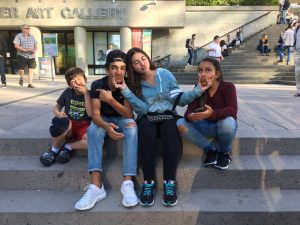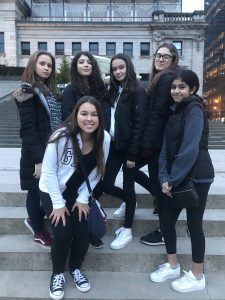Founded in 1931, The Vancouver art Gallery (VAG) sits in the unseated territory of the Musqueam, Squamish, and Tsleil-Waututh Peoples. The gallery honors First Nation people by not only respecting the land it is located on but also paying special attention to Indigenous artists and their accomplishments throughout history. The gallery builds a space where ideas, feelings, and stories can be shared in forms of art exhibits. By doing this, they also offer learning programs that teach and mentor the viewers about ancestors’ traditions and experiences from being first nations. The gallery is a great place to honor and learn about first nations even if you are a tourist, a local citizen, or a student doing research.
The Vancouver art gallery is now located in the space where the provincial courthouse used to be. Its large open squares have been the home for protests and social movements throughout Vancouver history. The Gallery’s director, Kathleen Barthels says to Georgia straight during an interview – “It’s a place where people gather and where democracy comes to life.” The art gallery is located in the heart and center of downtown, inviting people from all areas of the world to walk by and enjoy the scenery.
Being a known area for social movements, the stairs of the gallery now have a large number of dedicatory items in memory of the indigenous people who have died and suffered from residential schools. The recent discovery of more children found dead in abandoned residential schools has shaken the country and caused a series of social movements to honor those who suffered and were affected by the extremity that was residential schools.
The gallery is a center for social movements and it can resurface various kinds of memories to different people. Thinking of different ways a place can affect people, I can’t even imagine the countless amounts of memories the gallery holds. When I first saw the Vancouver Art Gallery, I had just moved into Vancouver and was still exploring the city from a tourist perspective. It was a really fun and different experience. While also being new to Canada, I had no previous knowledge of any of the first nation’s trauma and story. The gallery taught me the history of the land and if I remember correctly that was the first time, I had ever read anything about Indigenous people in Canada.
The art gallery, being one of my first ever places to visit in Vancouver, holds a special place in my memories. We learned in class about cultural memory and about objects of memory. I think that the gallery, by being in the heart of downtown, has become an object of memory to the people who see it often. In my high school years, my friends and I used to walk down to the gallery square after school, get food and hang out for hours. Now when I see the gallery, it reminds me of times from when I first moved, when I was hanging out with friends and having a good time.
On the Art gallery’s website, they have a written statement that says “-The Gallery stands against hatred, discrimination, racism, homophobia, and transphobia.” From my experiences in the gallery, I have never felt like I was disrespected or seen anyone being disrespected. The different types of groups that hang out around the VAG add a welcoming look to the building. There are skateboarders, photographers, art enthusiasts, and food enthusiasts enjoying the nearby restaurants. Moving forward while being an immigrant, I feel that I have to make more effort into learning about my country and I think a good start would be to try to be more involved with the gallery. Even if I’m just going to the exhibits I think art is a great learning form and I think it would be really great for me to visit and learn more about first nations and the country I live in.
I believe that one of the main reasons in which the art gallery has remained so popular is the way they invite children to learning programs to get them engaged at a young age. The gallery’s staff also seems to consistently work to stay up to date with social issues as well as being the home for many protests, so people can feel welcomed and comfortable regardless of their race, gender, and sexuality.
Link to history of protests at the VAG: https://www.insidevancouver.ca/2011/11/03/brief-history-of-protests-at-the-vancouver-art-gallery/
Link to the VAG’s website: https://www.vanartgallery.bc.ca

Me at the art gallery with one of my childhood friends and family who had come to visit me after moving away.

Me and my friends in grade 8 hanging out at the gallery after School

